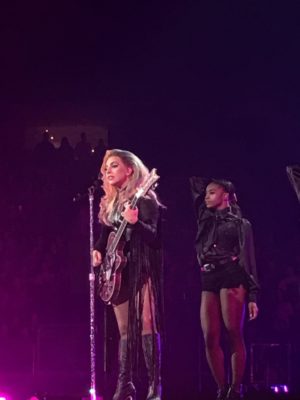
When pop icon Lady Gaga arrived onstage at the Wells Fargo Center on Sept. 10, she tipped her pink wide-brimmed hat while facing down onto her microphone, a hint of a smirk as she was greeted with enthusiastic screams and chants of “Gaga! Gaga! Gaga!”
Stopping for her first of two sold-out shows in Philadelphia, Pennsylvania as part of her Joanne World Tour, Gaga eventually made sure the audience heard the lyric, “Don’t call me Gaga,” from her song, “Monster,” which was taken from her epic “The Fame Monster” album back in 2009.
She then proclaimed, “Call me Joanne.”

Being the name for her latest album in 2016, Joanne is actually engrained in Gaga’s real name: Stefani Joanne Angelina Germanotta. Fans were shocked to hear her explore her vulnerable side and genres like country and soft rock with that album. It marked a dramatic departure from pop in her past albums.
The concert perhaps can be encapsulated in “Joanne,” the album’s title track which spoke volumes on why Gaga chose to take a route many did not imagine her taking with her career—not continuing with her usually thrilling pop songs.
Before performing the track, Gaga sat alone on a stool under a singular spotlight, the only person illuminated in the otherwise-dark arena, while sporting a guitar. Slowing the concert down from the usual high-paced and anthemic songs, she proceeded to tell a story about how growing up, her family was still grieving over Joanne’s untimely death.
Joanne was the name of her father’s sister, who died Dec. 18, 1974 at the tender age of 19.
While Gaga never met her as she was born in 1986, she confessed, “Ever since I was a little girl, at home with my grandparents, my sister and my family, I would watch my father get very upset, my grandpa get all choked up and have to leave the table, and my grandma start to cry. And I would get very confused until they told me this story about this angel, my father’s sister, who died when he was just 15 years old.”
Saying that when working with musician Mark Ronson on the record, Gaga said that this “intergenerational grief” was its core influence, being a way to reflect on how death is universal and how through music, she can try to alleviate the pain her family went through after Joanne’s death.
“Now I know where that pain comes from and I don’t have to feel bad about it anymore,” she said before playing her guitar and singing its somber lyrics, echoed by the audience singing along. “Cheers to you, Joanne, come on.”
Gaga, known for her electric presence and outrageous image, ironically shined most when she performed the more emotional hits of her discography and when she stripped down to just a musical instrument to accompany her strong vocals.
“Come to Mama” saw her asking audience members who don’t believe in equality to listen to her lyrics about letting people live their lives. Prior to that, she asked if anyone was in the LGBT community and if anyone is not, leading to defiantly raised hands and screams. The song showed how she embodied her Mother Monster moniker while she played from an iridescently-crystallized piano on a smaller stage so she was closer to the fans.
Another highlight was when a front-row fan from New Jersey threw a letter to the stage and Gaga picked it up and began reading it, learning that the man had struggled with his sexuality, and endured close-minded parents, loneliness and sexual harassment. The letter also indicated that “Hair” was his favorite song from her “Born This Way” album, which she briefly sang afterwards and she even went to hug him.
This led straight into “The Cure,” her most recent song, an upbeat pop track about love and support. Her famous messages for unconditional love and freedom were exemplified in “Born This Way,” where she travelled over the General Admission floor via pod-like bridges with a black-and-white wedding dress-inspired look, accompanied by her dancers.
“The Edge of Glory” was another emotional highlight where she slowed things down to have a young autistic boy named Owen sit beside her as she played the piano and sang confidently. She comfortably stretched the song from its five-minute length to over eight minutes, sprinkling it with speeches about bravery and respect.
The concert was colored with many of her signature hits, harking back to the late 2000s and early 2010s when Gaga was making headlines everywhere. While her presence in the industry and charts has somewhat dwindled due to her preferring a low-key persona to go with “Joanne,” her ability to handle a massive arena was still evident as she performed her more nostalgic hits like “Bad Romance,” “Just Dance,” “Telephone,” “Applause” and “Poker Face.”
Gaga concluded the two-hour concert with a moving rendition of “Million Reasons,” dedicating it to actor Bradley Cooper and his mother, Gloria, whom she revealed were in attendance, sending fans to a screaming frenzy. Cooper is a Philadelphia native and her co-star in the upcoming film, “A Star is Born.”
This last song served as an apt reminder of Gaga’s musical evolution, from delivering dancefloor-thrilling pop hits to message-laden numbers to more stripped-down songs that reveal more about the singer’s personal life.
The Joanne world tour is presumed to be Gaga’s last musical venture for a while as she recently announced while promoting her Netflix documentary, “Gaga: Five Foot Two,” that she’ll take another break after this year. She has cited her chronic pain and a need for self-reflection as main reasons for taking this break.
While the documentary will be available on the streaming platform on Sept. 22, her current tour will end on Dec. 18.
There has been a critical error on your website.<\/p>
Learn more about debugging in WordPress.<\/a><\/p>","data":{"status":500},"additional_errors":[]}
